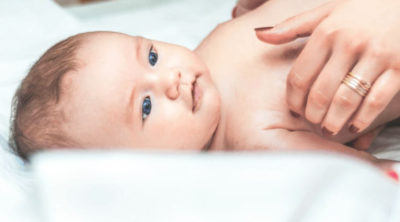Baby rashes are a common concern, especially to new parents. While some rashes may lead to health concerns, most are harmless if they are properly taken care of. Because of the delicacy of a baby’s skin, drool rashes on a baby’s face can develop quite often. It is essential to educate yourself on different types of rashes, treatments, and when to refer to medical help. If you are ever concerned about a developing rash, consult your pediatrician for medical advice.
What Causes a Drool Rash?
Drool rashes are among the most common rash developments that babies can experience. These rashes develop when the skin is exposed to constant moisture. Constant drooling, food, drinks, and pacifiers can cause the development of a rash. As the excess moisture collects on the skin, it causes irritation. Thus, resulting in patches of red bumpy skin. These patches can be flat or slightly raised, and can appear lighter or darker. These types of rashes can appear on your baby’s cheeks, chin, neck, and chest.
To avoid a drool rash on baby face, simply keep your baby’s skin free of excess moisture buildup over long periods of time. Clean your baby’s face, neck, and chest thoroughly after eating and drinking to prevent irritation. If your baby is teething, constant drooling is common. Gently dry your baby’s problem areas frequently throughout the day, and keep them in dry clothing.
How to Treat Drool Rash on Baby Face
While some rashes may disappear on their own, others may require a little extra attention. If your baby’s rash continues to worsen, here are some ways to help in the healing process.
- Wash the problem areas at least twice per day. It is essential to keep these areas clean to prevent bacteria infection. Use a gentle soap and water to clean the problem areas, and pat them dry with a clean towel.
- Use petroleum jelly or other moisture avoiding creams. Petroleum jelly acts as a barrier to the skin, preventing moisture from building up and settling into the pores. Even diaper rash creams can be useful, as they also prevent moisture from soaking into the skin.
- Use a soothing ointment- Rashes not only cause irritation to the skin, but they can also be uncomfortable for your baby. Using soothing balms can relieve your baby of any discomfort while the rash is healing.
While most rashes will heal after properly after caring for them, there are instances when you may need to seek medical attention. Warning signs you should look for include fever, unusual behavior, lethargy, or refusal to eat or drink. If you notice these symptoms in your baby, you should seek medical attention.
Most of the time, drool rashes are not generally a cause for concern. However, there are simple remedies to help accelerate the healing process. You can avoid future drool rashes from occurring by keeping problem areas clean and free of excess moisture buildup. If you are ever concerned about a rash or if it continues to worsen, talk to your pediatrician about your concerns and what they recommend to help heal the irritation.


